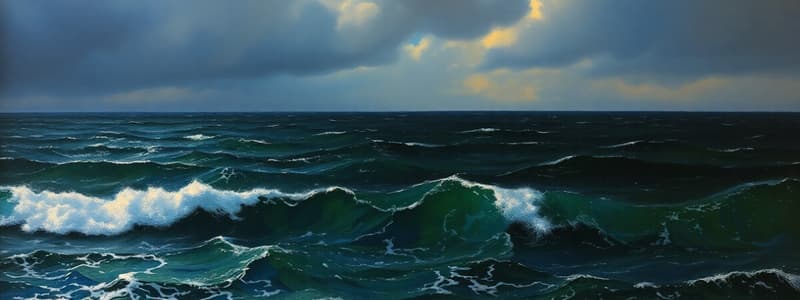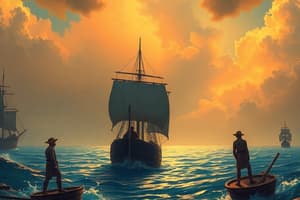Podcast
Questions and Answers
Which of the following statements best explains why the Atlantic Ocean has numerous natural harbours?
Which of the following statements best explains why the Atlantic Ocean has numerous natural harbours?
- The Mid-Atlantic Ridge protects coastal areas from strong currents and erosion.
- The ocean's high salinity prevents sediment buildup, maintaining deep channels.
- The 'S' shape of the ocean concentrates wave energy, naturally dredging ports.
- The highly indented coastline provides many sheltered locations for harbours. (correct)
If a ship is sailing from the Arctic Ocean to the Bouvet Islands, approximately how far would it travel along the Mid-Atlantic Ridge?
If a ship is sailing from the Arctic Ocean to the Bouvet Islands, approximately how far would it travel along the Mid-Atlantic Ridge?
- Approximately 16,000 km (correct)
- Approximately 4,000 km
- Approximately 8,000 km
- Approximately 12,000 km
Considering the geographical locations, which of these oceans would likely have the least impact on weather patterns in southern Australia?
Considering the geographical locations, which of these oceans would likely have the least impact on weather patterns in southern Australia?
- The Atlantic Ocean (correct)
- The Pacific Ocean
- The Indian Ocean
- The Southern Ocean
How does the unique geographic characteristic of the Indian Ocean influence its strategic importance?
How does the unique geographic characteristic of the Indian Ocean influence its strategic importance?
Which statement accurately describes a key difference between the Arctic Ocean and the Southern Ocean?
Which statement accurately describes a key difference between the Arctic Ocean and the Southern Ocean?
If the wind speed over the ocean increases significantly, what change would you expect to observe in the characteristics of the waves?
If the wind speed over the ocean increases significantly, what change would you expect to observe in the characteristics of the waves?
A research vessel measures the vertical distance between the crest and trough of a wave as 4 meters. What is the wave height?
A research vessel measures the vertical distance between the crest and trough of a wave as 4 meters. What is the wave height?
Considering the factors that cause ocean water movement, which of the following scenarios would most likely result in a strong ocean current?
Considering the factors that cause ocean water movement, which of the following scenarios would most likely result in a strong ocean current?
Flashcards
Atlantic Ocean
Atlantic Ocean
The second largest and busiest ocean, shaped like the letter 'S'.
Arctic Ocean
Arctic Ocean
The smallest ocean, located north of the Arctic Circle.
Indian Ocean
Indian Ocean
An ocean mostly in the southern hemisphere, named after a country.
Southern (Antarctic) Ocean
Southern (Antarctic) Ocean
Signup and view all the flashcards
Ocean Water Circulation
Ocean Water Circulation
Signup and view all the flashcards
Waves
Waves
Signup and view all the flashcards
Wave Crest
Wave Crest
Signup and view all the flashcards
Wave Trough
Wave Trough
Signup and view all the flashcards
Study Notes
Atlantic Ocean
- The Atlantic Ocean is the second largest and busiest ocean.
- It is less than half the size of the Pacific Ocean.
- It covers 20.8% of the Earth's total surface area.
- The ocean is shaped like the alphabet "S."
- It contains many shallow seas, for example, the Caribbean Sea, Baltic Sea, North Sea, Black Sea, and Gulf of Mexico.
- The coastline is highly indented, providing many sites for natural harbors.
- The Mid-Atlantic Ridge is an underwater mountain range on the ocean floor that runs roughly down the center.
- The Mid-Atlantic Ridge's total length is about 16,000 km from the Arctic Ocean in the north to the Bouvet Islands in the south.
Indian Ocean
- The Indian Ocean is located mostly in the southern hemisphere.
- It is the only ocean named after a country.
- It covers 14.4% of the Earth's total surface area.
- It is enclosed on three sides: the north by the landmasses of Africa, Asia, and Australia.
- The Southern Ocean meets it on the southern side.
- The ocean is roughly triangular in shape.
- It has high oil reserves.
- The Bay of Bengal and the Arabian Sea are its two northward extensions.
Antarctic or Southern Ocean
- It surrounds Antarctica.
- It occupies about 4% of the Earth's surface area.
- Large ice sheets cover this ocean for most of the year.
- Seas adjacent to it include the Scotia Sea, Amundsen Sea, and Ross Sea.
Arctic Ocean
- The Arctic Ocean is the world's smallest ocean, covering 2.8% of the Earth's total surface area.
- It is enclosed by the landmasses of North America, Asia, Greenland, and Europe.
- The Arctic Ocean is located north of the Arctic Circle.
- Many islands and marginal seas surround this ocean, such as the White Sea, the Baffin Bay, and the Kara Sea.
Ocean Water Circulation
- Ocean water is dynamic and moves continuously in vertical or horizontal ways.
- Movements are caused by factors such as differences in temperature and density, variations in salinity, and the effect of prevailing winds.
- Waves, tides, and currents are the major movements in oceans.
Waves
- Waves are a regular rise and fall of ocean and sea water due to the action of wind on the surface.
- The shape and size of waves depend on wind speed and other weather conditions.
- The upper part of a wave is a crest, while the lower part is a trough.
- Vertical distance between crest and trough defines wave height.
- Horizontal distance between two successive crests defines wavelength.
Studying That Suits You
Use AI to generate personalized quizzes and flashcards to suit your learning preferences.




